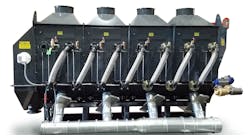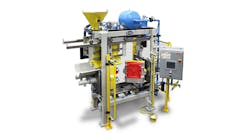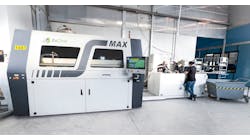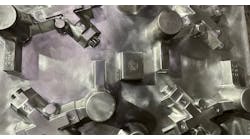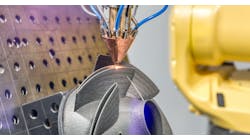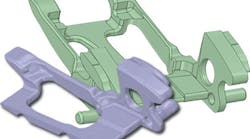Latest from Molds/Cores
When 3D Systems acquired software developer Geomagic Solutions earlier this year, it looked like a clever investment to consolidate revenues from the still evolving “additive manufacturing” market. Now, it looks like an indicator of some new technological shift.
Recently 3D Systems launched integrated design-to-manufacturing software tools under the Geomagic Solutions brand. It’s a combination of 3D Systems’ own, comprehensive reverse-engineering tools and an affordable mechanical CAD, plus fully automated inspection and verification software, with haptic modeling, to establish intra-operable design functionality. Geomagic includes a voxel-based modeler that is 3D printer-ready, enhancing engineering productivity and parts manufacturability.
The point here is that a single engineer — a casting designer, for example —working alone in an office, can develop a design, work through the various iterations, run the simulations, and issue a command to produce the prototype. All this is possible without trips to the lab or foundry, without issuing a RFQ or build order. Following that reasoning a bit further, desktop manufacturing becomes a reality.
3D Systems is one of a handful of companies that can credibly claim to have “established” 3D printing as a commercial enterprise. It supplies content-to-print solutions, including 3D printers, print materials, and on-demand custom parts services. It also provides CAD modeling, reverse engineering, and inspection software tools, and consumer 3D printers, apps and services.
Geomagic’s contribution is no less significant. Its scanning and design software captures and models 3D content from physical objects, organically sculpts complex shapes, and prepares products for manufacturing. In addition to the 3D modeling capabilities, it produces 3D metrology and inspection software that verifies dimensional quality by comparing as-built products to master designs. Also, Geomagic’s offers haptic devices that simulate the sense of touch in a digital environment.
Customers in aerospace, automotive, medical, consumer products, research, education, moldmaking, and other industries use Geomagic’s software and hardware.
Game-Changing Tools
“We are thrilled to re-shape the engineers’ desktop with game-changing, design-to-manufacturing tools that deliver enhanced productivity and embedded manufacturability,” according to Calvin Hur, vice president and general manager, 3D Systems Geomagic Solutions. “We are committed to provide optimal support for our new and existing products, ensuring our customers’ continuity and best overall experience.”
Additive manufacturing is the Holy Grail of economic growth. Virtually every sector of the economy — government, academia, industry … finance, design, manufacturing, retail — recognizes something in additive manufacturing (or if you prefer, 3D printing) that will invigorate their work and energize their profitmaking opportunities. No one really knows what will happen next, but everyone has a stake in the outcome.
3D printing has obvious applications for prototyping and patternmaking, and metalcasters have been in this discussion from the start, bringing their particular experience and at least partly directing the progress. Impressive progress has been made in 3D printing of molds and cores. Producing metal components is possible already, though for now the scalability of the process and material selection remain barriers to wide application.
Last month 3D Systems bought Phenix Systems (see p.7), gaining its product line for DLMS printers — portending new developments in the printing metal parts.
The open questions about additive manufacturing do not concern what can be produced, but how the production will be organized. Like 3D Systems recent purchase, Stratasys’ purchase of MarketBot reveals that the designers and builders of industrial 3D printing systems are maneuvering to hold a spot on the desktops, too: MakerBot’s 3D printers sell for $2,000-$3,000 each (check Amazon.com), a price that would seem to invite more designers and engineers directly in to the world of manufacturing.
The meaning of that for metalcasters is not clear, at least not while the issues of scalability and material selection remain. It’s likely there will be more competitors vying to produce the parts they now produce. Or, more hopefully, there will be fewer time and cost limitations to supplying their customers. Either way, there is about to be a lot more work landing on your desk.




